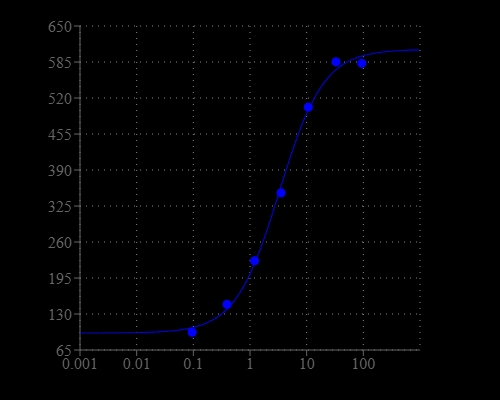Screen Quest™ CHO-Gqo Chimera Cell line
Screen Quest™ cell lines are a series of cells that have been successfully used in drug discovery and screening environments for studying G-protein-coupled receptors (GPCR) that do not conventionally couple through intracellular calcium. It has been effectively used with the FLIPR, FDSS Systems in conjunction with non-Gq coupled members of many receptors such as chemokine, serotonin, glutamate, dopamine, opioid, vasopressin and α- and β-adrenergic receptor families. Over 60% of the known GPCR signal through pathways other than Gq which lead to an increase in intracellular calcium, and as genomics reveals more G-protein-coupled receptor targets this trend continues to increase. Screen Quest™ cell lines are used for investigating G-protein-coupled receptors (GPCR) that do not conventionally couple through intracellular calcium. Screen Quest™ cell lines are based on a series of G-protein chimeras, including the promiscuous G-protein, Gα16. The chimeras consist of the alpha subunit of a Gq-protein complex whose 5 carboxy-terminal amino acids have been replaced with those from one of the other G-proteins (either Gαs, Gαi, Gαo, or Gαz). These amino acids are responsible for the coupling of the receptor to its G-protein. Co-expression of these chimeras with specific non-Gq-coupled receptors which normally act through the cAMP pathway may result in the generation of an intracellular calcium signal upon receptor stimulation. Screen Quest™ CHO-Gqo cell line is CHO-K1 cells stably transfected with the chimeric Gqo alpha subunit protein. When used as a host cell for transfection expression of Gi-coupled receptors, the constitutively expressed Gqo protein in the cells allows the transfected receptor which normally act through the cAMP pathway, to couple to Gq signal transduction and mobilized intracellular calcium. Activation of the specific non-Gq-coupled receptors in these cells by specific ligands can be detected using calcium sensitive dyes such as Calbryte 520 AM, Cal-520® AM, Fluo-8® AM, or Fluo-4 AM and no wash calcium kits.


| Catalog | Size | Price | Quantity |
|---|---|---|---|
| 38102 | Each | Price |
Storage, safety and handling
| H-phrase | H303, H313, H333 |
| Hazard symbol | XN |
| Intended use | Research Use Only (RUO) |
| R-phrase | R20, R21, R22 |
| Storage | Liquid nitrogen |
| UNSPSC | 12352200 |
Instrument settings
| Other instruments | ArrayScan, FDSS, FLIPR, FlexStation, IN Cell Analyzer, NOVOStar, ViewLux |
Contact us
| Telephone | |
| Fax | |
| sales@aatbio.com | |
| International | See distributors |
| Bulk request | Inquire |
| Custom size | Inquire |
| Technical Support | Contact us |
| Request quotation | Request |
| Purchase order | Send to sales@aatbio.com |
| Shipping | Standard overnight for United States, inquire for international |
Page updated on February 1, 2023
